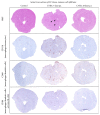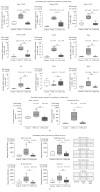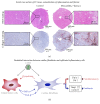Cardiac Function Remains Impaired Despite Reversible Cardiac Remodeling after Acute Experimental Viral Myocarditis
- PMID: 28352641
- PMCID: PMC5352897
- DOI: 10.1155/2017/6590609
Cardiac Function Remains Impaired Despite Reversible Cardiac Remodeling after Acute Experimental Viral Myocarditis
Abstract
Background. Infection with Coxsackievirus B3 induces myocarditis. We aimed to compare the acute and chronic phases of viral myocarditis to identify the immediate effects of cardiac inflammation as well as the long-term effects after resolved inflammation on cardiac fibrosis and consequently on cardiac function. Material and Methods. We infected C57BL/6J mice with Coxsackievirus B3 and determined the hemodynamic function 7 as well as 28 days after infection. Subsequently, we analyzed viral burden and viral replication in the cardiac tissue as well as the expression of cytokines and matrix proteins. Furthermore, cardiac fibroblasts were infected with virus to investigate if viral infection alone induces profibrotic signaling. Results. Severe cardiac inflammation was determined and cardiac fibrosis was consistently colocalized with inflammation during the acute phase of myocarditis. Declined cardiac inflammation but no significantly improved hemodynamic function was observed 28 days after infection. Interestingly, cardiac fibrosis declined to basal levels as well. Both cardiac inflammation and fibrosis were reversible, whereas the hemodynamic function remains impaired after healed viral myocarditis in C57BL/6J mice.
Conflict of interest statement
The authors declare that there is no conflict of interests regarding the publication of this paper.
Figures








Similar articles
-
Osteopontin: a fibrosis-related marker molecule in cardiac remodeling of enterovirus myocarditis in the susceptible host.Circ Res. 2009 Apr 10;104(7):851-9. doi: 10.1161/CIRCRESAHA.109.193805. Epub 2009 Feb 26. Circ Res. 2009. PMID: 19246678
-
Inhibition of coagulation factor Xa improves myocardial function during CVB3-induced myocarditis.Cardiovasc Ther. 2014 Jun;32(3):113-9. doi: 10.1111/1755-5922.12069. Cardiovasc Ther. 2014. PMID: 24533719
-
Adiponectin promotes coxsackievirus B3 myocarditis by suppression of acute anti-viral immune responses.Basic Res Cardiol. 2014 May;109(3):408. doi: 10.1007/s00395-014-0408-y. Epub 2014 Apr 2. Basic Res Cardiol. 2014. PMID: 24691762
-
Immunological aspect of cardiac remodeling: T lymphocyte subsets in inflammation-mediated cardiac fibrosis.Exp Mol Pathol. 2011 Feb;90(1):74-8. doi: 10.1016/j.yexmp.2010.10.004. Epub 2010 Oct 19. Exp Mol Pathol. 2011. PMID: 20965166 Review.
-
Inflammation and cardiac remodeling during viral myocarditis.Ernst Schering Res Found Workshop. 2006;(55):197-218. doi: 10.1007/3-540-30822-9_12. Ernst Schering Res Found Workshop. 2006. PMID: 16329664 Review.
Cited by
-
The influence of endurance exercise training on myocardial fibrosis and arrhythmogenesis in a coxsackievirus B3 myocarditis mouse model.Sci Rep. 2024 Jun 2;14(1):12653. doi: 10.1038/s41598-024-61874-x. Sci Rep. 2024. PMID: 38825590 Free PMC article.
-
Sex differences in the cardiac stress response following SARS-CoV-2 infection of ferrets.Am J Physiol Heart Circ Physiol. 2023 Nov 1;325(5):H1153-H1167. doi: 10.1152/ajpheart.00101.2023. Epub 2023 Sep 22. Am J Physiol Heart Circ Physiol. 2023. PMID: 37737732 Free PMC article.
-
Cardiac SARS-CoV-2 infection is associated with pro-inflammatory transcriptomic alterations within the heart.Cardiovasc Res. 2022 Jan 29;118(2):542-555. doi: 10.1093/cvr/cvab322. Cardiovasc Res. 2022. PMID: 34647998 Free PMC article.
-
Coxsackievirus A2 Leads to Heart Injury in a Neonatal Mouse Model.Viruses. 2021 Aug 11;13(8):1588. doi: 10.3390/v13081588. Viruses. 2021. PMID: 34452454 Free PMC article.
-
GPR15-mediated T cell recruitment during acute viral myocarditis facilitated virus elimination and improved outcome.Nat Cardiovasc Res. 2024 Jan;3(1):76-93. doi: 10.1038/s44161-023-00401-z. Epub 2023 Dec 27. Nat Cardiovasc Res. 2024. PMID: 39195892 Free PMC article.
References
-
- Caforio A. L. P., Pankuweit S., Arbustini E., et al. Current state of knowledge on aetiology, diagnosis, management, and therapy of myocarditis: a position statement of the European Society of Cardiology Working Group on Myocardial and Pericardial Diseases. European Heart Journal. 2013;34(33):2636–2648. doi: 10.1093/eurheartj/eht210. - DOI - PubMed
MeSH terms
Substances
LinkOut - more resources
Full Text Sources
Other Literature Sources

